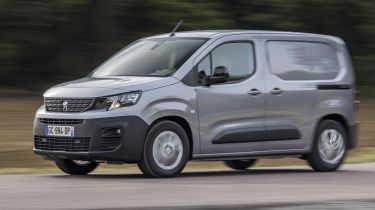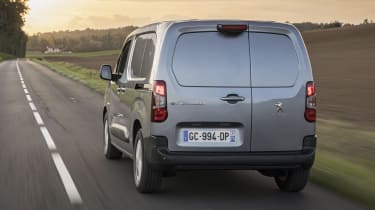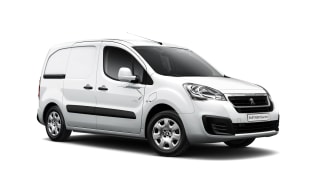Peugeot e-Partner review
The smallest electric van in the Peugeot range is a very accomplished all-rounder

Pros
- Versatile
- Well equipped
- Car-like driving experience
Cons
- More expensive than diesel
- Some cheap-feeling plastics
- Range may not be long enough for some
| Van type | Range | Wallbox charge time | Rapid charge time |
|---|---|---|---|
| Electric | 170 miles | 7hrs 30mins (0-100%, 7.4kW) | 30mins (10-80%, 100kW) |
Peugeot has introduced a number of plug-in hybrid and electric passenger cars in recent times, and it’s arguably been even swifter at electrifying its commercial vehicles: since autumn 2021, all of Peugeot’s vans have been available with pure-electric powertrains. There's the mid-size e-Expert and larger e-Boxer, as well as this: the compact e-Partner, which is a sister model to the Citroen e-Berlingo and Vauxhall Combo Electric small vans that we've also driven.
Like that pair, it boasts a driving range of 170 miles and a maximum payload of 803kg. Power comes from the same 134bhp electric motor and 50kWh battery combination used in almost every other electric vehicle from the Stellantis brands and the 260Nm of torque on tap comes in very handy for tackling steep hills or dealing with a heavy load in the back.
Charging can be completed overnight in seven-and-a-half hours from a 7kW wallbox, while out and about the van can be replenished at speeds of up to 100kW from a public rapid charger. That's enough to take the battery from near-empty to 80% full in about half an hour, so topping up in the course of your lunch break is entirely doable.
On the road, the e-Partner is surprisingly good to drive for a basic small van – largely due to the fact that its mechanical underpinnings are shared with passenger-car models like the Peugeot e-208 and Citroen e-C4 hatchbacks. Engine noise is totally absent, of course, while wind and road noise are kept sufficiently at bay, too. Ride quality is also decent, even if you've got nothing in the back.
A low centre of gravity comes courtesy of the heavy battery back being mounted in the van's floor. That gives the e-Partner slightly better road manners than its diesel-engined counterpart, as well as making it more stable in crosswinds, so drivers will find a lot to like here. They'll also probably enjoy the e-Partner's well appointed interior. The example we drove was the entry-level Professional Premium+ trim, coming in at just under £36,000 once the plug-in van grant has been applied. Even this cheapest edition gets air-conditioning, cruise control and an eight-inch screen in the dashboard for controlling the various on-board systems.
We haven’t yet driven an e-Partner in its plusher Asphalt Premium+ trim, though this version does come with some useful features depending on what you’ll be using the Peugeot for. For instance, the rear parking sensors and rear-view camera are handy to have when you’re reversing into awkward spots. If the higher-end versions of the e-Partner’s sister vans are anything to go by, the extra sound deadening on this trim keeps road noise down and makes the Peugeot even more relaxing to drive.
Regardless of the trim level, quality is solid throughout, even if some of the door and dashboard trim feels a little low-rent. The majority of the plastics should put up with abuse and clean off easily – although we did notice the touchscreen surround felt a bit wobbly, so we wouldn't recommend hanging anything heavy off it.
On the practicality front, the e-Partner acquits itself well. There's a load-through flap in the bulkhead, allowing you to carry items up to 2.1 metres long without having a rear door hanging open, depending on whether you go for the Standard or Long body length. Opt for an e-Partner with the folding front bench seat, and you can boost the load bay length to 3.4 metres. Additionally, there’s also a Crew Van model with an extra row of seating – just be aware you can only have the Long bodystyle on this Peugeot e-Partner version, and prices start at just over £40,000 after the plug-in grant has been applied.
It all sounds pretty good then, but the elephant in the room is the Peugeot’s price. Even with the savings from the plug-in van grant, the e-Parter costs nearly £12,000 more than its like-for-like diesel equivalent. The difference doesn't seem as stark when you consider a 15,000-mile fuel bill for the latter will come to around £2,000 a year, so you won't be long making back the difference with the considerably cheaper-to-run electric model. And it's an absolute no-brainer if work takes you within the London Congestion Charge zone, as the e-Partner is exempt from having to pay this until 2025.
Overall, the e-Partner (and its sister models) is a very convincing zero-emissions small-van package. We'd have no hesitation recommending you order one right now, but if you’d prefer something with a longer range you may want to also look at the Nissan Townstar EV and Renault Kangoo E-Tech, which can go a bit further on a single charge than the Peugeot. Those who can wait may also wish to see how the new Mercedes eCitan and Ford E-Transit Courier stack up, when they arrive in late 2023 and late 2024 respectively.




